![[Metroactive Features]](/features/gifs/feat468.gif)
[ Features Index | Silicon Valley | Metroactive Home | Archives ]
Trunk With Power: Ganesh, the god of success and destroyer of obstacles.
Battling the Past
Indian parents and scholars go to war over how Hindu history is taught in California schools
By Vrinda Normand
MADHULIKA SINGH from Milpitas says her 11-year-old son came home from school one day and told her he didn't want to be a Hindu anymore because kids were teasing him on the playground.
"I was sick to my stomach," Singh, an Indian-born Yale graduate who has lived in the United States for 23 years, recalls. "We practice what we're telling him, but he goes to school and learns otherwise."
The books that Madhulika's son uses in school describe the Goddess Kali, revered by Hindus for her cosmic power, as "bloodthirsty." They call Hanuman, a god worshipped for his loyalty and protection, the "monkey king."
One exercise tells students that Hanuman loved Rama (a Hindu god) so much that some believe he appears every time the Ramayana (ancient Sanskrit epic) is read. "So look around—see any monkeys?" the passage taunts.
Hindu parents like the Singhs are also disturbed that the schoolbooks refer to the Vedas, or earliest Hindu scriptures, as songs, poems, myths and legends. The lessons, they say, explain reincarnation and karma dismissively: "Evil deeds cause a person to be reborn as a lower being, such as an insect" and "If you had earned bad karma, you might come back as a chicken, a fish or a pig. ... Even a mosquito had a soul."
Text Wars
Religious groups, academics, activists and parents are waging a war over grade-school textbooks. Heated battles are pitting science against faith, authenticity against ideology, sensitivity against reality. Tensions are reaching a boiling point as one government body decides who gets to write history.
Although each side has hurled the word "creationist" as an epithet, neither has anything to do with Christianity—nor the intelligent design controversy that created a national furor in 2005 when a Pennsylvania Federal Court judge ruled that religion cannot be taught in science class.
The culture at stake now originates on the other side of the globe, in a country that is home to more than 1 billion people: India. Waves of South Asian immigrants to the United States have transplanted an old identity-politics debate into fertile California soil.
California is now home to more than 300,000 people of Indian descent, with more than 20 percent of them living in the San Jose area. Nearly 40,000 Indian students attend California schools in grades K-8.
Over the next six years, they and millions of their peers will read the standardized sixth-grade textbooks on world cultures teaching Hinduism and ancient India. The chapters they will study are currently being reviewed by the California State Board of Education.
This government process started last year by welcoming public input. It has since morphed into a drawn-out headache for board members and anxious publishers, while stirring international criticism, media coverage and Internet hate campaigns.
The rivals in this conflict have created a whirlwind of rhetoric and blame. Both sides are trying to paint the issue in black and white. Both claim to have the only reasonable point
of view.
And ironically, both stand behind California law. The state Education Code Section 60044 has two provisions that dictate how governing boards adopt instructional materials.
One says that educational material may not contain "any matter reflecting adversely upon persons because of their race, color, creed, national origin, ancestry, sex, handicap, or occupation." Hindu parents, religious groups and educators have capitalized on this sentence to argue that current textbooks are unlawfully offensive and degrading to Hinduism and Indian culture.
The other provision says that the same materials may not contain "any sectarian or denominational doctrine or propaganda contrary to law." Scholars, activists and human-rights groups are touting this line to combat what they call fundamentalist Hindu efforts to sanitize Indian history and glorify Hinduism to the detriment of minority groups.
Searching for middle ground has been a bumpy ride.
Mission to Sacto
At 6am, the sky forms a dark backdrop against a growing trail of headlights on Highway 680. While commuters snake through the Central Valley on their way to work in the Bay Area, Anu Mandavilli drives in the opposite direction. The thirtysomething activist with Friends of South Asia (FOSA), a Silicon Valley-based human-rights group, is on a mission to make her voice heard in the state Capitol.
The Board of Education meeting this January morning in Sacramento starts at 9am. That hasn't stopped Mandavilli and nearly 20 other volunteers and academics from waking up before dawn to make the three-hour journey. After a hurried caffeine fix at a nearby coffee shop, the group heads toward the marble-floored state building to register for public comment.
Professor Lawrence Cohen from the University of California, Berkeley, tells the board that he is "distressed by what appears to be a deeply sectarian and unscientific text" proposed by two groups: the California chapter of the Hindu Education Foundation based in the South Bay (HEF) and the Vedic Foundation based in Texas (VF).
"The many-headed hydra of Hindu fundamentalism is working in my own backyard," says Sonya Pelia, a mother and FOSA member.
"Such beliefs [put forward by the HEF and VF] are not consistent with science," Mandavilli says. "They belong in books of mythology, not history."
Editing History
These testimonies come after a flood of letters and several heated meetings held with the state Board of Education and the Curriculum Commission appointed to oversee the textbook-review process.
The controversy began in September 2005, when members of the Hindu Education Foundation and the Vedic Foundation approached the board with more than 200 edits to a handful of sixth-grade textbooks covering Hinduism and Indian history. HEF parents said they felt much of the content was demeaning and made their children embarrassed to be Hindus.
Sunil Erraballi, a member of HEF, says the descriptions in the textbooks make the symbolism of Hindu teachings look silly when taken out of context.
To deal with the volume of public input, the Curriculum Commission created an ad hoc committee. Director Tom Adams says he appointed Shiva Bajpai, a practicing Hindu and retired professor of ancient India at California State University Northridge, on the recommendation of the HEF.
Bajpai and the committee approved nearly 75 percent of the changes proposed by the HEF and VF and passed their recommendations on to the board, which would make a final decision on Nov. 9.
But a countercampaign interrupted this process. The parental concerns of the HEF and VF, critics said, aren't as straightforward as they seem.
On Nov. 8, Harvard Indologist Michael Witzel sounded a panic alarm. He sent a letter, scrambled together in 48 hours with the names of 50 professors from around the world, urging the board "to reject the demands by nationalist Hindu [Hindutva] groups that California textbooks be altered to conform to their religious-political views."
Witzel branded the proposed changes "unscholarly" and says he would have acted "sooner and with greater force" if he had discovered earlier what the HEF and VF were trying to do.
"It would trigger an immediate international scandal if the California State Board of Education were to unwittingly endorse religious-nationalistic views of Indian history," Witzel warned. "These opinions do not reflect the views of the majority of specialists on ancient Indian history nor of mainstream Hindus."
Members of the board certainly took notice. Adams says they were uncomfortable accepting the ad hoc committee's suggestions and sent them back to the Curriculum Commission for a factual review. They also sought the advice of three consultants: Witzel, James Heitzman from the University of California, Davis, and Stanley Wolpert from the University of California, Los Angeles.
In doing so, the board set the battleground for a culture war that has erupted on two continents. "You have no idea the level of absurdity this has become," says Steve Farmer, a Palo Alto historian and Witzel's research partner.
Debating the Past
The most contentious topics covered in the textbooks are the origins of Hinduism, the caste system and the status of women.
The first of these subjects, in which Witzel specializes, deals with the theory of Aryan migration. Some scholars believe that the Aryans (the Indian nobility) originated in Central Asia because their language, Sanskrit, has many similarities to ancient dialects of that area. This would mean that the Vedas, written in Sanskrit, came with the Aryans when they are thought to have migrated to the subcontinent around 1500 B.C.E.
The father of this theory, 19th-century German scholar Max Muller, originally came up with the idea of an Aryan invasion, a more dramatic hypothesis. It says the Aryans dominated the indigenous Indian people with superior technology, imposing on them Hinduism and the caste system.
Although the linguistic evidence for this theory is strong, it is still debated among archeologists and geneticists. Witzel admits it is "a theory like any other and can be falsified," but he has yet to see evidence convincing him otherwise.
Hindu scholars, including professor Bajpai, point to the fact that the Vedas make no reference to such a migration. He sides with HEF members who request it be taught as a "theory that some scientists believe." The current textbooks refer to the Aryan invasion as fact.
On a more emotional level, the proposition that Hinduism is not native to India is extremely touchy for a lot of people. Singh from the HEF says the Aryan invasion is the "mother of all racist theories" because it was used to justify British colonization.
Mihir Meghani, president of the Fremont-based Hindu American Foundation, which supports the HEF initiative, says Indian communist groups have promoted the theory to prove that Hindus are "just another invader."
Witzel and his FOSA supporters combat these arguments with more political darts. Mandavilli says that claiming Hindus are native to India is part of the Hindutva agenda.
"Hindu nationalism is the idea that India is only for Hindus," she says. In other words, boosting a national Hindu image threatens to undermine a secular government and minority rights within a diverse Indian society.
According to the 2004 U.S. State Report, Hindus make up 82 percent of the Indian population, Muslims 12 percent, Christians 2.3 percent and Sikhs 2 percent. Other religious groups include Buddhists, Jains, Parsis (Zoroastrians), Jews and Baha'is.
The report identifies "Hindutva" as a politicized religious movement comprised of several groups, including the Bharatiya Janata Party (BJP) and the Rashtriya Swayamsewak Sangh (RSS). Both have been implicated in sectarian violence against Christians and Muslims. In 1948, an RSS member assassinated Mahatma Gandhi, the world-famous political leader who challenged the caste hierarchy.
Gender Flags
Activist groups spotted red flags in attempts to soften or "whitewash" India's history of caste and gender inequalities. They felt that the Hindu Education Foundation and the Vedic Foundation edits reeked of Hindutva propaganda that denies the dark side of Hindu culture.
FOSA, along with the Coalition Against Communalism and a handful of advocate groups representing the Untouchables (now referred to as Dalits, the lowest and most oppressed Indian caste), joined forces with the Witzel-led academic team. Their grassroots campaign has expanded the sixth-grade textbook issue into a forum for social commentary.
"The edits represent the systematic erasure of women and Dalits in India," Mandavilli says, insisting that the caste system still "defines life in India" and gender discrimination thrives.
The HEF and VF have requested that many references to the treatment of Dalits be deleted from the textbooks. They argue that the caste hierarchy is a thing of the past—now illegal according to the Indian constitution.
Mandavilli points out that this is like saying racism no longer exists in the United States because slavery is illegal.
"I know what's going on with caste discrimination through my own experience," says Thillai Kumaran, a South Bay software engineer who comes from a "backwards caste" in South India. "To say otherwise is like saying the sun sets in the east."
Mandavilli also pounced on euphemistic descriptions of women's roles in ancient India supported by "separate but equal" reasoning. The HEF suggested that the line "Men had more rights than women" be changed to "Men had different rights and duties than women."
"What the hell does that mean?" Mandavilli retorts. "Inmates have different rights compared to people outside the prison? Yeah sure, if that's the way you put it. I can't believe people are buying it," she says.
Caste Calls
Despite the hype about "religious extremists," Singh and Erraballi of the HEF don't exactly fit the mold of militant, nationalist crusaders. Both work as high-tech professionals in the Silicon Valley and have lived in the United States for more than 20 years.
Singh is married to a Caucasian Christian man and every morning leads her mixed-race children in Hindu prayers asking for world peace.
Erraballi says many of his religious views are actually considered "liberal" and gives his son and daughter freedom in following Hindu values.
"We do accept the fact that there are inequalities in India, as there are everywhere," Erraballi says. "There is a cultural practice that has been there for centuries. It's dying."
He points to the Indian "reservation system" (like affirmative action) that helps disadvantaged people of lower castes attain higher education. Kumaran from FOSA got an engineering degree through this system and now enjoys a much higher standard of living in the United States.
Singh adds that India's former president, Shankar Narayanan, was from the lowest caste, and the former prime minister, Indira Gandhi, was a woman. Today, religious minorities lead the country: a Muslim president, a Sikh prime minister and a female, Catholic head of Congress.
Erraballi and Singh argue that caste and gender inequalities shouldn't be associated with their religion, especially not to impressionable 11-year-old children.
"There are problems with how women are treated in every society," Erraballi says. "We are ashamed if there is any discrimination practiced in our identity. The question is: Is it a widespread uniqueness to Hinduism? Absolutely not."
In fact, Singh says, the opposite is true. "The way we raised my son, mother has a higher place than father. We have goddesses that are prayed to every day. We have female priests."
Professor Bajpai agrees with the need for extra sensitivity in grade-school lessons on religion. "These are very complicated ideas for sixth graders," he says.
"In post-9/11 America it's extremely important to present different cultures accurately and fairly," adds Meghani of the HAF, "in a way that will not just promote negative stereotypes."
Reading Reality
Mandavilli says she is not fooled by this excuse. "It's true that Indians face discrimination in mainstream America, but you know what, this is not the way to solve it."
"It's never a good policy to hide things from kids," she continues. "They should read about reality. Why should pride rest on denying negative things about your religion?"
"It's not as if Hinduism is singled out," Witzel adds, pointing out vivid examples in other schoolbooks that teach kids about Protestants being burned to death during the Catholic reformation, Muslims being massacred by Christian crusaders, Spanish colonial exploitation in South America and slavery in ancient Rome.
Mandavilli says it would be "nonsense to claim that these examples make the publishers anti-European or anti-Christian."
Kumaran and Mandavilli view the so-called Hindutva supporters as elitist Brahmins (belonging to the highest caste) who are trying to preserve the status quo. "They act like they're the victims here," Kumaran says, "but they were the culprits for thousands of years."
And so the mudslinging begins. Generalizations issue from each end, widening the gap between "fundamentalist freaks" and "cold-hearted communists."
Witzel and FOSA stamp the Hindutva label on the HEF by presenting an old RSS website as evidence of the connection; on it, an American branch of the Hindutva organization boasts the creation of the local foundation. An HEF spokesman recently admitted to the Wall Street Journal that a member of the RSS founded his group, but it now "acts independently."
To Metro, HEF's Khanderao Kand claims, "RSS and HEF have no relationship. Today, HEF represents Hindu parents from a broad cross-section of Hindu-Americans including many that have no affiliation with the RSS."
Singh and Erraballi act dumbfounded as to why anyone would think they're political. "We are just parents focusing on the textbooks. That's all we care about," Singh sighs.
"We felt like we were being slapped in the face," Erraballi adds. "He [Witzel] wrote the letter without even looking at the textbooks."
Critics also point to HAF president Meghani as a clear sign of fundamentalist affiliation. He published an article on the BJP website titled "Hindutva: The Great Nationalist Ideology."
Meghani did not respond to Metro's attempts to confirm his byline. Earlier he told us, "FOSA has tried to defame Hindu activism by calling us Hindutva. Just because we want to portray Hinduism accurately and positively doesn't make us fundamental."
Farmer calls the HAF a "phony human-rights organization" constructed as a front to hide a more sinister agenda.
"They're basically hate groups," Mandavilli says.
Battle-Hardened
Meghani and a rampant backlash of Indian bloggers are responding with a barrage of accusations.
"It's pretty well known that they're [FOSA] tied with the Communist Party in India," the HAF president says. "It's really a ploy to break down and dissemble Hinduism."
Vishal Agarwal, an angry Santa Rosa parent, says, "You will find a lot of information on their past association with Islamist and other dangerous groups." He supports his view with a "watchdog" website (authors unknown) presenting links between FOSA and Aid India, an allegedly communist organization that provides charity and sponsors lectures on Marxism.
Mandavilli calls this claim "meaningless."
"I am not a member of any political party. No one in my group is affiliated with any communist party," she says. Later she adds, "Being affiliated with the communist parties is not something we should defend ourselves against. The politics of our group is irrelevant since we have not proposed any edits."
Witzel jokes that according to the Indian right-wing press, he became a communist in 2000. "It just happened to me. I didn't even know about it."
The Sanskrit professor says he is "battle-hardened" by now, tolerating blows like the following petition being circulated by Srinivasan Kalyanaraman, who is listed as an adviser on the HEF website.
The petition demands that Harvard "end its association with Aryan Supremacist/Creationist hatemongering activities. Professor Michael Witzel and his 'scholars clique' in the Harvard Sanskrit and Indian Studies Department have exhibited a pattern of hateful, ignorant statements and abysmally low standards of scholarship. Witzel's activities have made Harvard the object of anger, disgust, contempt and ridicule of ordinary citizens."
Harvard has responded by standing behind Witzel. Tensions are so high that some activists and academics are afraid to make their support public.
Witzel says his favorite hate email came with only one word: "Bastard." Another read, "Nazi, I hope you die soon." A few days later he received a note from the same author: "Are you still alive?"
"We cannot take such things seriously," the Harvard professor laughs.
Mandavilli, however, is not laughing about the message she recently found in FOSA's inbox:
"What an org. you motherfuckers, katwa boot-lickers. Many of you could be product of rapist sulemans or pedophile pastors. Many of you use Hindu names and backstab Hindus. You shit mongrels. God give me strength to slaughter you. He will."
Gladiator Show
"I know they are taking it too far," Bajpai acknowledges. "Once you unleash this kind of vehemence, it's difficult to be reasonable."
He admits to losing his cool on Jan. 6 when he and Witzel, who flew in from the East Coast, faced off at a private board meeting. The two academics debated for nearly six hours in what Bajpai compares to a "gladiator show."
Witzel called Bajpai "religious-minded." Bajpai called Witzel "close-minded." The Indian professor says he became so exhausted that he told his Caucasian opponent, "You don't understand anything."
In the end, they were able to compromise on a few edits. The textbooks would give both views of the Aryan migration theory and use the specific phrase "Men enjoyed more property rights than women."
At the Jan. 12 public board meeting, president Ruth Green announced a new committee had been formed to examine the edits—yet again. A final decision will be made in March. Metro called Green about the ordeal that she and the board have gone through, but she would not comment while the process is pending.
Linda Hess, a professor of Hinduism at Stanford University, seems to be one of the few moderate voices in this vicious dispute. A professor of Indian culture for 25 years, she knows what it's like to be caught in the middle.
Hess has dined with some of the HEF members and listened to their side of the story. She knows some who are aligned with Hindu nationalist politics and some who are not. She has even invited a few Hindu parents to lecture for her university classes.
Hess can also relate to the liberal academics she has associated with for decades. When competing campaigns started recruiting signatures, she didn't join either side. She says the political and academic issues have been "mixed up with the legitimate concerns of a minority immigrant community."
"To the extent that representations in textbooks are ignorantly hurtful to Indians and Hindus," she says, "I would always support their removal or change."
At the same time, Hess says she would scrutinize differing versions of history as a scholar. "I would not defer those corrections to Hindus simply because they're Hindus," she explains, adding that among Christians there are "wildly divergent versions of history."
Her solution? Well, it may be a stretch considering the rift between warring factions on this issue. She suggests that both sides be included in writing history.
"I think scholars of religion live in the real world too," Hess says. "We shouldn't feel immune to the forces of politics. It's important to get a variety of religious and political voices in our classrooms."
A visit to a Hindu temple in Sunnyvale reveals the variety of Indian religious experience in the valley
A YOUNG INDIAN couple enters the Sunnyvale Hindu Temple holding a bunch of bananas. The dimly lit gathering hall, large enough to pack in thousands of visitors on holidays, holds only a few worshippers this quiet weekday afternoon. One man sits cross-legged, his back erect, meditating with his eyes closed. An elderly woman stands with her hands pressed together in prayer fashion, bowing her head toward the altar.
This sacred platform is the central source of activity in the temple. The Indian couple takes the fruit offering here as a token of respect for the deities displayed. The brass and marble figures of dozens of gods and goddess, revered for their unique qualities and powers, represent the plurality of Hindu beliefs. The temple's co-founder, Raj Bhanot, explains that each deity has his or her "own department." For example, Hindus believe that Brahma is the creator, Vishnu the preserver of the universe and Shiva the destroyer. They also pray to Saraswati the goddess of knowledge, Laxmi the goddess of wealth and Durga the universal mother.
"We say God is one but has many forms," Bhanot says. Worshipping one form means they are ultimately worshipping the same unifying force. The different faces and names of this force are what attract a wide variety of Hindu followers.
Shiva Bajpai, a retired professor of Indian culture and scholar of the Vedas, or ancient scriptures, explains that the Hindu God is like infinity. He/she can be one and many at the same time, male and female, imminent (present in this world) and transcendent (above this world). People can practice their religion inside a temple, outside in nature and within their own hearts.
While the diversity of Hinduism is often presented as harmonious, many still argue over what is "authentic." Being thousands of years old, the religion has branched off into sects with spiritual leaders paving different paths to God. Here in the Silicon Valley, Hindus from many paths and backgrounds find themselves in the same place. Bhanot says the temple welcomes 500-800 people every week, and everyone "mixes freely."
Ganesh Sharma, a young priest wearing a white cotton wrap, rings a hand-held bell while reciting Sanskrit mantras or prayers. The gentle murmur of his voice echoes throughout the spacious hall. He assists the visitors in offering food, flowers and incense. In the daily aarti ceremony, he will offer natural elements like these along with a fire-lit lamp, water in a conch shell and fragrant sandalwood paste. "We have to respect everyone," Sharma says, "because God is inside everyone."
Vrinda Normand
[ Silicon Valley | Metroactive Home | Archives ]
![]()
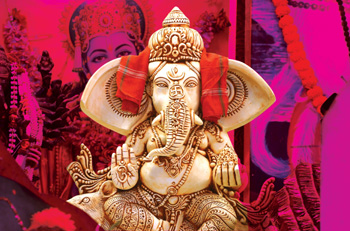
Photographs by Felipe Buitrago
The Players
HEF—Hindu Education Foundation, South Bay group lobbying for textbook changes
VF—Vedic Foundation, Texas group lobbying for textbook changes
HAF—Hindu American Foundation, Fremont-based national group supporting the HEF and VF
FOSA—Friends of South Asia, Silicon Valley human rights organization opposing the textbook changes
RSS—Rashtriya Swayamsewak Sangh, a large Indian Hindutva organization alleged to be connected to the HEF
BJP—Bharatiya Janata Party, political arm of the Hindutva movement in India
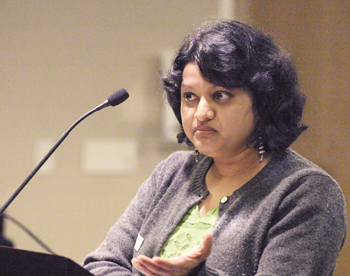
Parental Control: Anu Mandavilli opposes textbook changes.
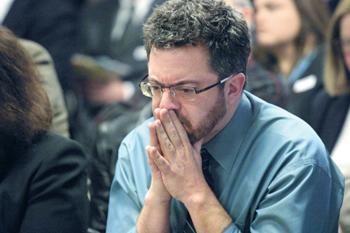
Professional Distance: UC-Berkeley scholar Lawrence Cohen is distressed by sectarian proposals.
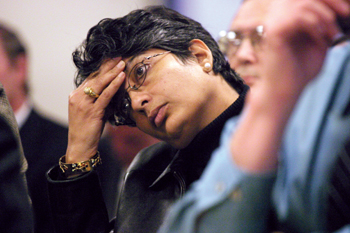
Opposing Voice: Sonya Pelia listens to testimony in Sacramento.
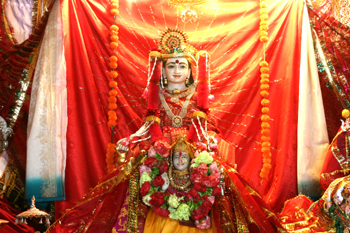
Temple Times
Send a letter to the editor about this story to letters@metronews.com.
From the February 1-7, 2006 issue of Metro, Silicon Valley's Weekly Newspaper.